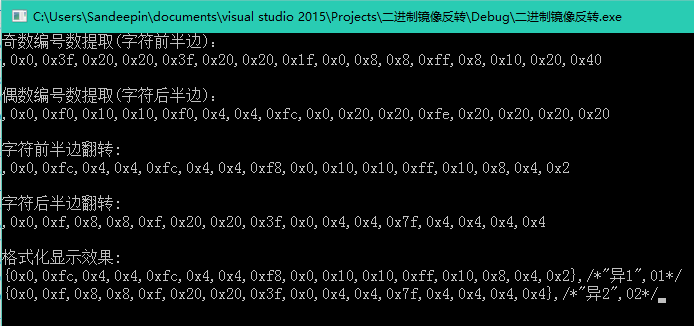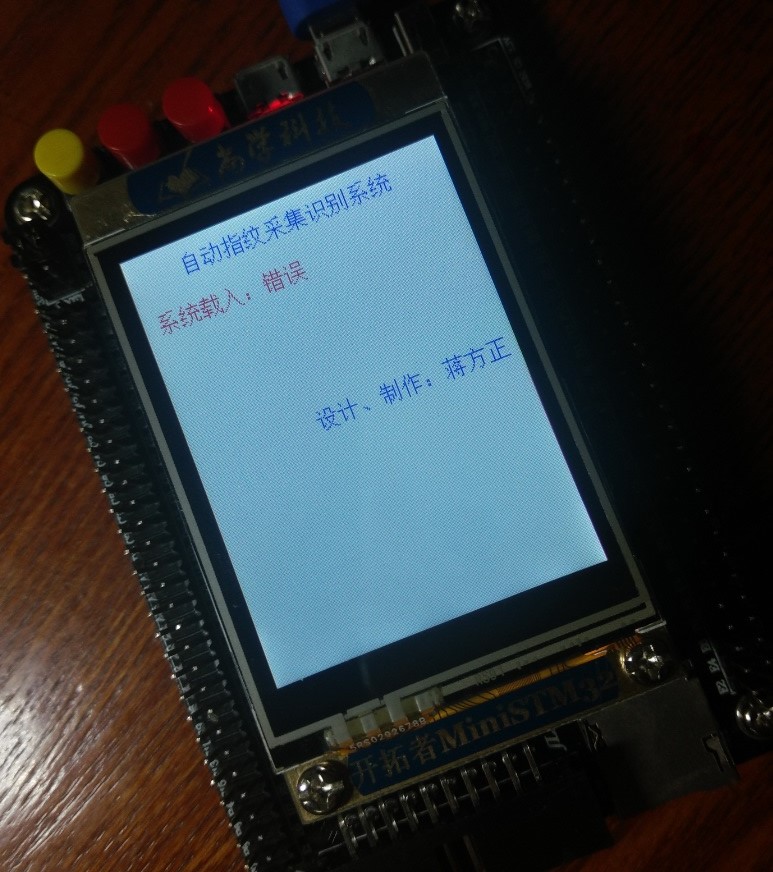STM32操纵2.4寸液晶(ILI9325)
我做的毕设是自动指纹采集识别系统,当然现在还不能把代码放出来。不过在做的过程中用到了液晶显示,配套的例子里刚好有TFTLCD显示实验代码,但它的代码只能显示英文,为了急用,我懒得调用字库,于是自己折腾了一套方法显示中文,现把过程简单记录一下。
液晶屏上的中文显示(Sandeepin的办法)原理:利用两个16x8的显示格子拼凑一个汉字。
用到的字模软件:字模III v3.9。我转换异想家的“异”字得到如下字模:
用字模III v3.9生成的是16x16横向排的字模,且镜像反转了,不配合本液晶系统,需要用到我制作的C语言算法转换:
#include "stdafx.h"
int revse32int(int a, int len) //len是要旋转的数字位数,从右侧起
{
int tmp = 0, i, j;
for (i = 0, j = len - 1; i < len; ++i, --j)
{
if ((a >> i) & 1)
tmp |= ((a >> i) & 1) << j;
}
return tmp;
}
int main(void)
{
//字模软件直接得到的字模
int yuan[32] = { 0x00,0x00,0x3F,0xF0,0x20,0x10,0x20,0x10,0x3F,0xF0,0x20,0x04,0x20,0x04,0x1F,0xFC,
0x00,0x00,0x08,0x20,0x08,0x20,0xFF,0xFE,0x08,0x20,0x10,0x20,0x20,0x20,0x40,0x20 };
int i = 0,j = 0;
int jishu[16] = {};//奇数编号数存数组
int oushu[16] = {};//偶数编号数存数组
for (i = 0; i < 32; i++)
{
if (i % 2 == 0)
{
jishu[j] = yuan[i];
j++;
}
}
printf("奇数编号数提取(字符前半边):\r\n");
for (i = 0; i < 16; i++) printf(",0x%x", jishu[i]);//奇数编号数提取(字符前半边)
printf("\r\n");
j = 0;
for (int i = 0; i < 32; i++)
{
if (i % 2 != 0)
{
oushu[j] = yuan[i];
j++;
}
}
printf("\r\n偶数编号数提取(字符后半边):\r\n");
for (int i = 0; i < 16; i++) printf(",0x%x", oushu[i]);//偶数编号数提取(字符后半边)
printf("\r\n");
printf("\r\n字符前半边翻转:\r\n");
for (int i = 0; i < 16; i++) printf(",0x%x", revse32int(jishu[i], 8));//字符前半边翻转
printf("\r\n");
printf("\r\n字符后半边翻转:\r\n");
for (int i = 0; i < 16; i++) printf(",0x%x", revse32int(oushu[i], 8));//字符后半边翻转
printf("\r\n");
printf("\r\n格式化显示效果:\r\n");
printf("{");
for (int i = 0; i < 16; i++)
{
if (i == 0) printf("0x%x", revse32int(jishu[i], 8));
else printf(",0x%x", revse32int(jishu[i], 8));
}
printf("},/*\"异1\",01*/");
printf("\n");
printf("{");
for (int i = 0; i < 16; i++)
{
if (i == 0) printf("0x%x", revse32int(oushu[i], 8));
else printf(",0x%x", revse32int(oushu[i], 8));
}
printf("},/*\"异2\",02*/");
getchar();
return 0;
}效果如下:
张帮我写了个Python版本,更好用,也把代码附上:
#!/usr/bin/env python3
# -*- coding: utf-8 -*-
def ch(x):
x = ((x&0x55)<<1)|((x&0xaa)>>1)
x = ((x&0x33)<<2)|((x&0xcc)>>2)
x = ((x&0x0f)<<4)|((x&0xf0)>>4)
return x
def change():
nums = eval(input('ctrl+c退出或者继续输入:'))
L1 = []
L2 = []
l = len(nums)
i = 0
j = 1
k = 1
for i in range(l):
if i % 2 == 0:
L1.append(ch(nums[i]))
if i % 2 != 0:
L2.append(ch(nums[i]))
le = len(L1)
print('{',end = '',file = f)
for i in L1:
if j <= 15:
print('0x%02x,' % i, end = '',file = f)
else:
print('0x%02x},' % i, end = '',file = f)
j = j + 1
print(file = f)
le = len(L2)
print('{',end = '',file = f)
for i in L2:
if k <= 15:
print('0x%02x,' % i, end = '',file = f)
else:
print('0x%02x},' % i, end = '',file = f)
k = k + 1
print(file = f)
print('\n',file = f)
n = int(input('要输入多少中文字符:'))
f = open("./output.txt", 'a+')
for i in range(1,n+1):
print('第%d个字:\n' % i,file = f)
change()
print('已输出第%d个字' % i)之后将转换后的字模添加到font.h中(图中的例子不是“异”,而是我的名字,举一反三):
const unsigned char CH_1616[100][16]={
{0x10,0x10,0xff,0x10,0x0,0x10,0x92,0x54,0x14,0x10,0xd8,0x94,0x12,0x11,0x10,0x10},/*"蒋1",00*/
{0x4,0x4,0x7f,0x4,0x1,0x1f,0x8,0x5,0xa,0x9,0x7f,0x8,0x9,0x9,0x8,0xc},/*"蒋2",01*/
{0x40,0x80,0x80,0xff,0x20,0x20,0x20,0xe0,0x20,0x20,0x20,0x10,0x10,0x8,0x4,0x2},/*"方1",02*/
{0x0,0x0,0x0,0x7f,0x0,0x0,0x0,0xf,0x8,0x8,0x8,0x8,0x8,0x8,0x5,0x2},/*"方2",03*/
{0x0,0xfe,0x80,0x80,0x80,0x80,0x88,0x88,0x88,0x88,0x88,0x88,0x88,0x88,0xff,0x0},/*"正1",04*/
{0x0,0x3f,0x0,0x0,0x0,0x0,0x0,0x1f,0x0,0x0,0x0,0x0,0x0,0x0,0x7f,0x0},/*"正2",05*/
}; 在text.c中加入:
void LCD_ShowChar_CH(u16 x,u16 y,u16 num,u16 Color)
{
u16 temp;
u8 mode=0;
u8 size=16;
u8 j,t;
u8 count;
u16 x0=x;
if(x>MAX_CHAR_POSX||y>MAX_CHAR_POSY)return;
//设置窗口
if(mode==0) //正常显示
{
for(j=0;j<size;j++)
{
temp=CH_1616[num][j];
count=8;
for(t=0;t<count;t++)
{
if(temp&0x01)
{
LCD_DrawPoint(x,y,Color);
}
else
{
LCD_DrawPoint(x,y,BACK_COLOR);
}
temp>>=1;
x++;
}
x=x0;
y++;
}
}
}
void LCD_ShowString_CH(u16 x,u16 y,u16 chnum,u16 Color)
{
if(chnum==1)//选择菜单(录入、清空)
{
LCD_ShowChar_CH(0+x,0+y,6,Color);LCD_ShowChar_CH(8+x,0+y,7,Color);
LCD_ShowChar_CH(16+x,0+y,8,Color); LCD_ShowChar_CH(24+x,0+y,9,Color);
LCD_ShowChar_CH(32+x,0+y,10,Color);LCD_ShowChar_CH(40+x,0+y,11,Color);
LCD_ShowChar_CH(48+x,0+y,12,Color);LCD_ShowChar_CH(56+x,0+y,13,Color);
LCD_ShowString(64+x,0+y,"(",Color);
LCD_ShowChar_CH(72+x,0+y,14,Color);LCD_ShowChar_CH(80+x,0+y,15,Color);
LCD_ShowChar_CH(88+x,0+y,16,Color);LCD_ShowChar_CH(96+x,0+y,17,Color);
LCD_ShowChar_CH(104+x,0+y,18,Color);LCD_ShowChar_CH(112+x,0+y,19,Color);
LCD_ShowChar_CH(120+x,0+y,20,Color);LCD_ShowChar_CH(128+x,0+y,21,Color);
LCD_ShowChar_CH(136+x,0+y,22,Color);LCD_ShowChar_CH(144+x,0+y,23,Color);
LCD_ShowString(152+x,0+y,")",Color);
}
if(chnum==2)//指纹识别模式
{
LCD_ShowChar_CH(0+x,0+y,24,Color);LCD_ShowChar_CH(8+x,0+y,25,Color);
LCD_ShowChar_CH(16+x,0+y,26,Color); LCD_ShowChar_CH(24+x,0+y,27,Color);
LCD_ShowChar_CH(32+x,0+y,28,Color);LCD_ShowChar_CH(40+x,0+y,29,Color);
LCD_ShowChar_CH(48+x,0+y,30,Color);LCD_ShowChar_CH(56+x,0+y,31,Color);
LCD_ShowChar_CH(64+x,0+y,32,Color);LCD_ShowChar_CH(72+x,0+y,33,Color);
LCD_ShowChar_CH(80+x,0+y,34,Color);LCD_ShowChar_CH(88+x,0+y,35,Color);
}
}以后就可以在主函数中随处调用了:
LCD_ShowString_CH(40,10,2,BLUE);//x、y轴指定显示位置,字库中对应显示文字,颜色
附上一张我做的指纹识别系统泄漏图:
- 上一篇: STM32学习笔记:基础例子
- 下一篇: STM32操纵DHT11湿度传感器



